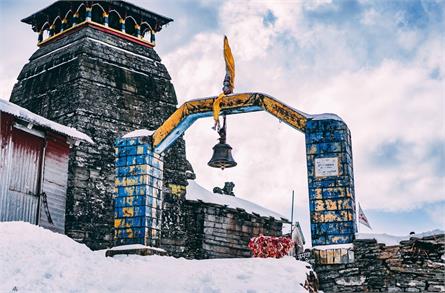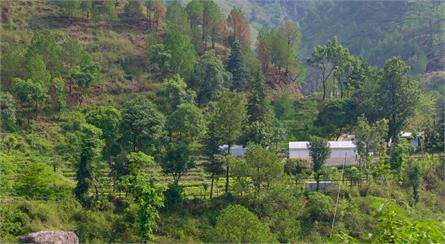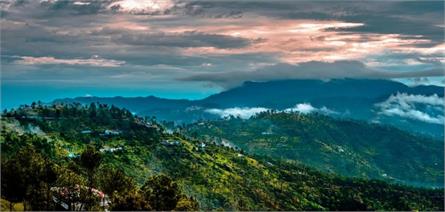"Mystical Abode: The Sacred Enclave of Jageshwar Temple, Uttarakhand"
,Almora--4504cd.jpg)
Find out the echoes of history resonate throughout the Jageshwar Temple, beckoning us to explore the enigmas of our innermost selves!
"Devotee places are not just physical locations, but spiritual sanctuaries where one can connect with their inner self and find peace."
Many such religious places exist in Devbhoomi Uttarakhand, whose description has also found in Puranas. There are several historical and mythological temples on the abode of sages in which Hindu devotees have immense faith. Jageshwar Temple Dham is one such religious place in Almora district, Uttrakhand. This temple is amid deodar forests 38 km from the Almora district of the Kumaon division.
Jageshwar Temple is known as Hatkeshwar in Puranas and Patti Parun in land revenue accounts. The natural beauty of holy Jageshwar Temple, situated at about 6200 feet above sea level on the banks of Patit Pawan Jata Ganga, is incomparable.
Jageshwar Temple is referred to as Uttarakhand's "fifth Dham". Jageshwar Temple has a group of 125 temples. 4-5 temples are prominent, where worship is done according to the method. All the temple groups in Jageshwar Temple Dham have been built in the Kedarnath style. Jageshwar Temple is famous for its architecture. These massive temples made of big stones are magnificent.
Also Read: Almora - the Cultural Capital of Kumaon
History
According to ancient belief, Jageshwar Temple Dham is the penance place of Lord Shiva. Here Nava Durga, Surya, Hanuman, Kalika, and Kaleshwar are prominent. Every year in the month of Shravan, a festival has held in Jageshwar Temple Dham for the whole month. Rituals, chanting, earth worship etc., take place in this place. Foreign tourists also come here a lot. The Jageshwar Temple has temples of all the main deities of the Hindus. Two temples are unique, one for "Shiva" and the other for "Mahamrityunjaya form" of Shiva. In Mahamrityunjaya, the pain, like death, is also averted by chanting, etc. Built-in the 8th and 10th centuries, the Katyuri kings built this temple group, but people believe that the Pandavas created the temple. Historians believe that Katyuri and Chand's rulers constructed them.
Sacred Places in Jageshwar Dham
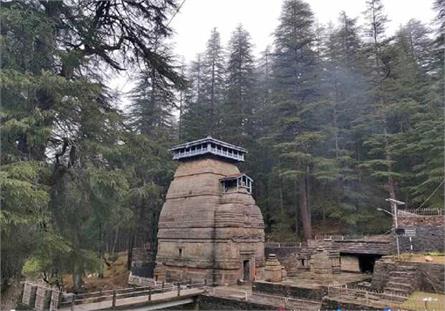
Jageshwar Temple is a city that boasts several impressive stone temples, many dating back to the 9th to 13th century AD. These temples include the Dandeshwar Temple, Chandi Temple, Jageshwar Temple, Kuber Temple, Mritunjaya Temple, Nanda Devi or Nau Durga, Nava-grah Temple, a Pyramidal shrine, and Surya Temple. The Mahamandal Temple is the largest of the Mahadeva Temples, while Dandeshwar Temple is the biggest temple of Jageshwar Temple.
During the Gupta Empire in North India, was Katyuriraja in the Himalayan hills' Kumaon region. During the same period, temples had built. For this reason, a glimpse of the Gupta Empire has visible in these temples. The Archaeological Survey of India says the construction period of these temples has three periods. Katyurikal, Uttar Katyurikal and Chandra period. With their distinctive constructions, these brave Kumaon rulers constructed more than four hundred temples not only in Jageshwar Temple, which is located in the centre of the snowy region.
There are about 250 small and big temples in Jageshwar Temple itself. The temples have huge stone slabs instead of wood and cement. The door frames have ornamental images of gods and goddesses. Copper sheets and deodar wood have also been used in these temples. Among these shrines, the oldest is the 'Mrityunjaya Temple', and the biggest is the 'Dandeshwar Temple'. Jageshwar Temple used to be the epicentre of Lakulish Shaivism and is located in the Jataganga river valley, near a Deodar forest (Cedrus deodara), beginning from the Artola village on the Almora-Thoragarh highway. It stands where two streams, Nandini and Surabhi, trickle down the hills and meet at a sacred location in the narrow valley.
Also Read: Kedarnath Temple
Myth
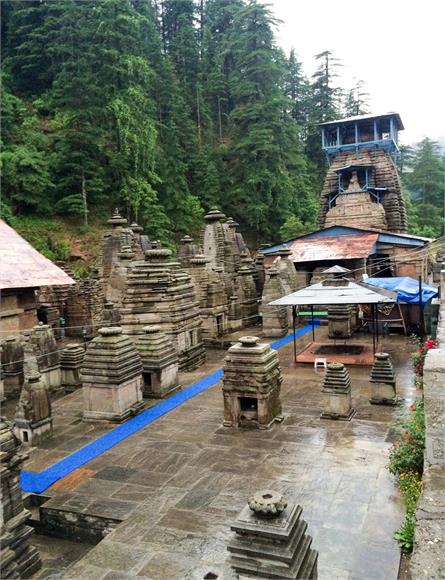
The Puranas state that Lord Shiva and the Saptarishis performed penance in this area. The Jageshwar temple's vows were being exploited in the past, so Adi Shankaracharya arrived in the eighth century to end this. He accomplished this by nailing the Shivling installed in Mahamrityunjaya. As a result, the wishes of those who wish harm to others are not granted here. Only positive wishes may be fulfilled through Yagya and rituals.
Formation of Shivlinga
According to a legend, Lord Shiva, saddened by the self-immolation of Mother Sati in Daksha Prajapati's yagya, wrapped the Yagya's ashes and meditated for a long time in the dense forests of Daruk Van. That's why this place is known as the abode of Shiva. In these forests, the seven sages, like Vashishtha and their wives, used to do penance by making huts. Once Lord Shiva was engrossed in meditation in the Digambar state, during that one day, the wives of these seven sages went to the forest for roots, fruits and, wood etc., their eyes fell on Digambar Shiva. Seeing the well-formed body of Lord Shiva, the wives of the sages were fascinated by Lord Shankar. Lord Shankar was engrossed in his penance. He ignored him, and then the sages' wives fell unconscious after being blinded by lust.
When they did not return to their huts for the whole night, the sages went out to find them in the morning. Then the Saptarishis saw that Shiva was engrossed in samadhi and his wives were lying unconscious, so they felt that Lord Shiva had committed adultery with their wives, and in this apprehension, they cursed Lord Shankar and said that 'You have committed adultery with our wives'. You have committed adultery, so your penis should immediately fall apart from your body.' Lord Shiva opened his eyes and said, 'You people have done this because of ignorance seeing me in suspicious circumstances, so I will not oppose this curse. My penis will automatically fall and be established at this place. All seven sages will also hang in the sky along with the stars for eternity. As soon as the linga separated from Shiva, there was uproar in the whole world. Brahmadev asked the sages to worship Maa Parvati to save the world from its wrath. Brahmadev knew that only Parvati could imbibe this glory of Shiva. Sages worshipped Mother Parvati. Parvati appeared in the form of a vagina and held the Shivling. Hence, this Shivling is renowned by the name of Yogeshwar Shivling.
Also Read: The exotic life in hill station Nainital
The myth behind the formation of Temples
It has believed that Luv-Kush, the sons of Maryada Purushottam Lord Rama, had fought with their father's army. They came here after becoming the king. Luv-Kush had organized a yagya at this place to atone for the war out of ignorance, for which they had invited the gods. It is said that Luv-Kush had first established these temples. That Yagya Kund is still present here. Shiva worship is mentioned in Jageshwar Temple Dham by Ravana, Pandavas and Markandeya Rishi. Even today, there is much silent evidence of Pandavas having shelter here. However, evidence has yet to be found about who built the temple.
Wheather
Jageshwar Temple is a place with cool summers and very chilly winters. During December and January, there is snowfall in Jageshwar Temple. The climate of Kausani, on the other hand, is salubrious and provides a hygienic environment. The atmosphere of Kausani is charming, which attracts tourists to the place.
Architechture of Temple/ Katyuri style.
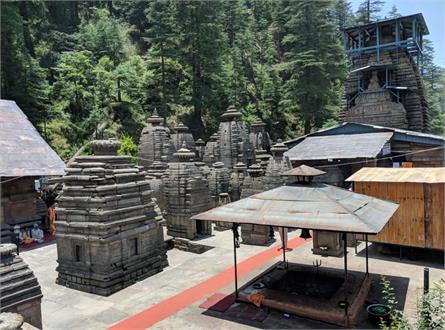
All the temples in Jageshwar Temple Dham are built in the Katyuri style. Famous for its architecture, this temple is known as the Tapasthali of Lord Shiva. The stream of the Jata Ganga river flows by the side of this temple which comes under the Archaeological Department. It is believed that the Saptarishis did penance here, and the worship of Lord Shiva as a linga started from here. The remarkable thing is that Lord Shiva is worshipped in a child or young form. One hundred twenty-four small and big temples are dedicated to Lord Shiva in Jageshwar Temple Dham. It is believed that Based on the belief of the local people, the Shivling of this temple was declared as Nagesh Linga. A small river stream also flows by the side of this temple.
Jageshwar Temple monsoon festival
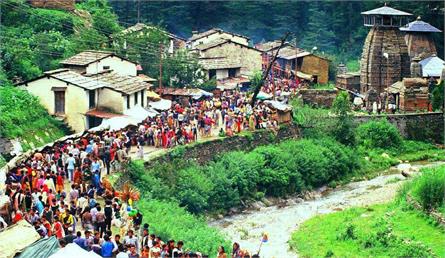
The Jageshwar Temple Monsoon Festival is a popular event in Jageshwar Temple in the month of Shravan. It's a celebration of the monsoon season and features a variety of cultural and religious activities. One of the most important festivals in the Kumaon region is the Maha Shivratri Mela, held during spring. This festival is celebrated enthusiastically by people from all walks of life. It's a time for prayer, reflection, and renewal, symbolizing the triumph of good over evil. Jageshwar Temple is a beautiful pilgrimage centre, and the beauty here is worth seeing. Devotees from all over the country and abroad come here and perform Rudrabhishek of Lord Shankar. Apart from Rudrabhishek, worships like Parthiv Puja, Kalasripa Yoga Puja, and Mahamrityunjaya Jaap are performed here. Special events are also organized here in Mahashivaratri; on this occasion, many devotees visit.
Some Temples are said to be between the 7th to 12th centuries.
There is no written history of Jageshwar Temple. Looking at the architecture and style of many temples present here, they are said to be between the 7th to 12th centuries. According to the Archaeological Survey of India, some temples here are said to be from the Gupta period, and some temples are from the second century. Some people believe these temples may be during Katyuri or Chand dynasty, but there is no evidence. It is also said about this place that Adi Shankaracharya built some of these temples, but this is just a claim.
Best Time To Visit
April to June or September to November
These are considered the best times to visit this beautiful destination. During these months, the weather is generally pleasant, and you can enjoy all the outdoor activities and sightseeing without hassle.
Best Hotel near Jageshwar Temple
The town offers a limited range of options, including deluxe hotels, standard hotels, and budget hotels that cater to the needs of travellers visiting the holy shrine. You can also check out the Tourist Rest houses available in Jageshwar Temple.
1. Van Serai
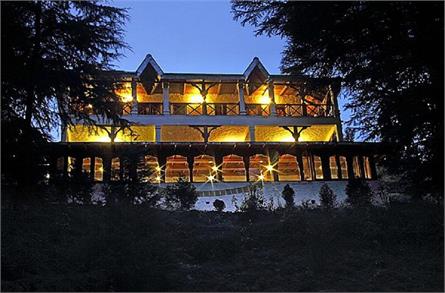
Van Serai is a wonderful place to stay if you want to explore the ancient Himalayan Shiva temples. Just a few minutes from the Himalayan Jageshwar Temple Dham Temple complex, this eco-lodge has surrounded by beautiful deodar woodlands and offers four double rooms. The serene ambience is perfect for yoga and meditation, and guests can enjoy nature walks and birding. If you're interested in traditional Kumaoni village life, this is the place to be. And don't forget to check out Cafe Swayambhu, where you can indulge in delicious homemade traditional Indian food. Van Serai offers excellent stay options, whether on a pilgrimage tour or a Himalayan Safari. The famous Himalayan Village Ways trek starts from Binsar and ends at Jageshwar Temple, making Van Serai the perfect base for your adventure.
2 Jageshwar Temple Jungle Lodge
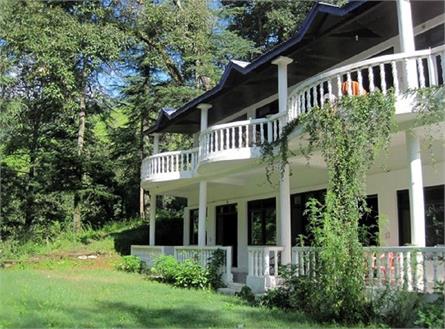
Jageshwar Temple Jungle Lodge is a great option to stay near the dense and protected Deodar/pine forest in Jageshwar Temple town of Almora District of Uttarakhand. It's located near the origin of the holy Jata Ganga River and is just a 35-45 minute walk (with no hike on hills) from the Jageshwar Temple in Almora. The walk to the lodge is parallel to the Jataganga River, making it a beautiful and serene location for nature enthusiasts.
3. Hobo Huts by the Riverside
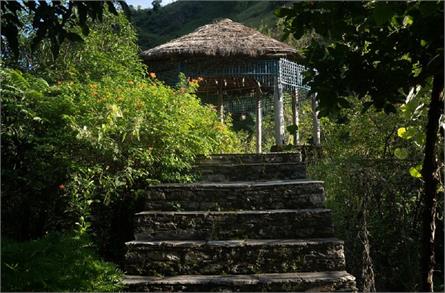
The huts are cosy and comfortable, and the location by the river is truly serene. It's the perfect place to disconnect from the chaos of everyday life and relax in nature. The staff is amiable and accommodating, and they go above and beyond to ensure their guests are happy. We highly recommend a stay at Hobo Huts for anyone looking to unwind and recharge in a beautiful setting.
4. Binsar Adventure Camp
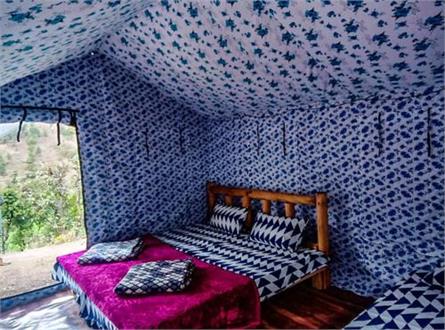
Binsar Adventure Camp offers stunning mountain views. Along with comfortable and clean accommodations, the camp also boasted a lovely garden and terrace where guests could relax and take in the breathtaking scenery. One of the highlights of the stay is the delicious buffet and vegetarian breakfast available at the luxury tent. It has the perfect way to start the day and fuel up for any future adventures.
5. The Bharat Residency
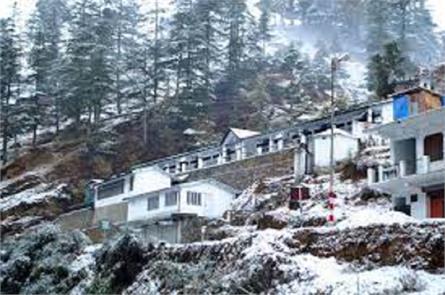
The Bharat Residency is a great place to stay for those looking to explore the city of Jageshwar Temple Dham. Whether you're traveling for business or leisure, this hotel promises a comfortable and pleasant stay. After a long day of sightseeing, guests can unwind in the hotel or explore the city. Additionally, parking facilities are available for guests, making it easy to get around and explore the area.
How to reach Jageshwar Temple Dham
Situated in Almora district, the cultural capital of Uttarakhand, Jageshwar Temple, can be reached from Kothgodam and Dehradun. While Kathgodam can be reached by rail, Doon can go by air. There are direct bus and taxi facilities from Kathgodam to Almora. To reach Jageshwar Temple in Uttarakhand, you can use the following modes of transportation:
1. By Air
The nearest airport to Almora is Pantnagar, a famous agricultural university, about 167 km from Jageshwar Temple and 127 km from Almora. The journey by road from Pantnagar to Jageshwar Temple takes around 4-5 hours.
2. By Rail
The nearest major railway station to Jageshwar Temple is Kathgodam Railway Station, approximately 125 kilometres away. Kathgodam is well-connected to various cities in India. From Kathgodam, you can hire a taxi or take a bus to Jageshwar Temple. The journey from Kathgodam to Jageshwar Temple takes around 3-4 hours.
3. By Road
Jageshwar Temple is well-connected to nearby cities and towns in Uttarakhand through a network of roads. You can reach Jageshwar Temple by road from several major cities. Here are some common routes:
From Delhi: The distance between Delhi and Jageshwar Temple is approximately 400 kilometres. You can drive from Delhi to Jageshwar Temple via the Hapur-Moradabad-Rudrapur-Haldwani-Almora route.
From Dehradun: The distance between Dehradun and Jageshwar Temple is around 320 kilometres. You can drive from Dehradun to Jageshwar Temple via the Rishikesh-Haridwar-Ramnagar-Ranikhet route.
From Nainital: The distance between Nainital and Jageshwar Temple is approximately 100 kilometres. You can drive from Nainital to Jageshwar Temple via the Almora-Binsar route.



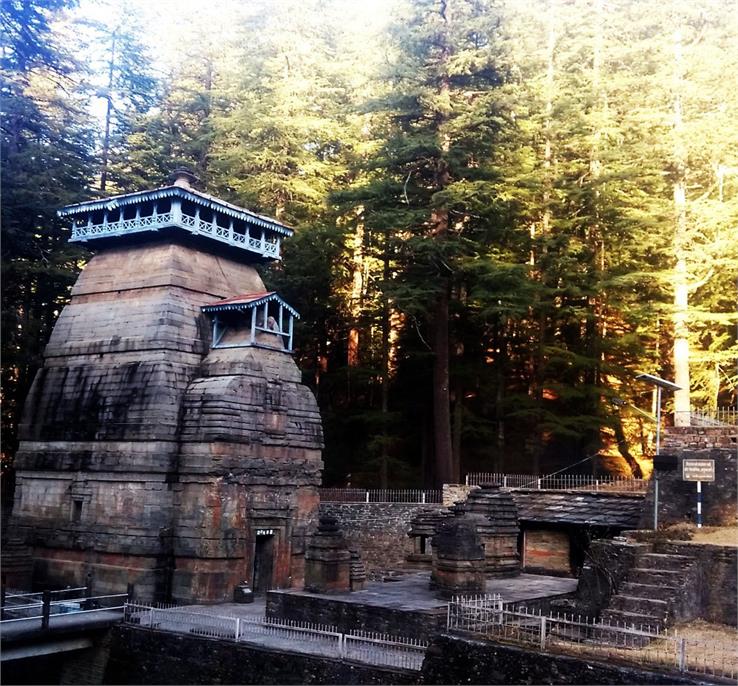
,Almora--4504cd.jpg)









